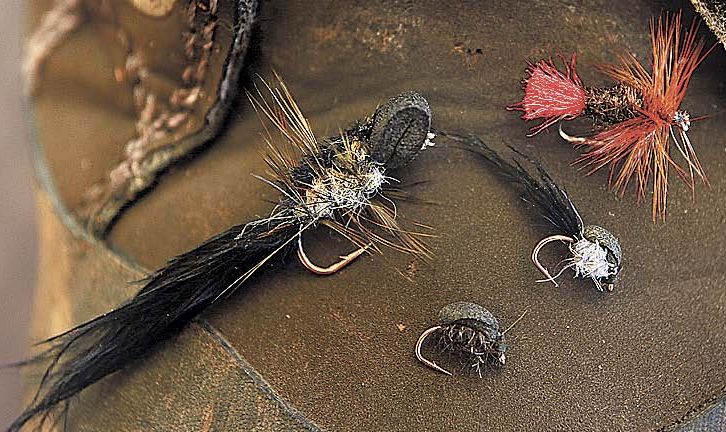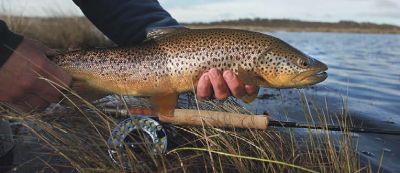 Presented from Issue 112, October 2014
Presented from Issue 112, October 2014
The sight of a taking a floating fly is an image that will stay with you forever. It’s not just the act of a trout taking a floating fly that makes this so special, it’s every second leading up to that point followed by that crucial pause before finally lifting the rod to set the hook and hopefully, feel the weight of a hooked fish. When it all comes together, there’s no better feeling in fly-fishing.
Tailing scenarios
October and November are very good months to find tailing trout in our highland lakes. Prime tailing waters are lakes that have a shallow shoreline that will expose the fins and subtle movements of fish that have moved into the shallows to feed with the safety of low light conditions during dawn, dusk and at times overcast conditions.
There are two tailing scenarios to consider. Trout that are feeding on aquatic life and those that are feeding on terrestrials, grubs, worms and any other land based food item that has been inundated by a sudden rise in the lake level. If you’re fortunate enough to be on a lake that has just pushed up onto new ground for the first time and trout are feeding on a variety of land based food items, then the fishing can be spectacular. But once this short term supply of food has been depleted these newly formed shallows can be totally void of fish, putting an end to any prospect of finding tailing fish, so high water does not always equate to tailing fish. The exception to this is when lakes and rivers flood into shallow lagoons that already have an established aquatic eco system.
When seeking out a lake to find tailing fish it’s a much safer bet to choose a shallow lake that has a gradual sloping shoreline and an established weed growth. Three lakes that certainly fit these criteria are Little Pine Lagoon, Lake Kay and Double Lagoon.
The other consideration is of course the weather. Clear night skies often bring with it sub zero temperature that freeze the shallow margins where trout would normally be foraging for food. On these icy mornings it’s often better to concentrate your time looking for tailing fish during the evening. Overcast nights with temperatures above freezing are the ones that are always worth getting out of bed for.
 Floating flies
Floating flies
There is nothing new about catching tailing trout on floating flies, fly anglers have been doing this for years. During my early years of fly fishing, I vividly remember watching anglers at Little Pine lagoon catch tailing trout on a size 12 Red Tag. If only it was that easy!
Sometimes it is, but there are many days when you have to dig a bit deeper to get them to lift their head. Over the years I’ve had some success turning some of the sub surface flies use for tailing trout, into floaters. I use the term ‘floaters” loosely as some of these flies float in the surface film. Some are easy to see while others disappear the moment they hit the water. My four favorite floating flies for tailing trout are a size 14 Red Tag, size 10 or 8 EWB (emerging Woolly Bugger), size 14 or 16 foam back -black beetle and a size 14 foam back –tadpole.
Let me be the first to say that using floating flies is not always the best way to catch tailing fish. I tend to persevere with a floater longer than I should on some days simply because I love to see a trout take a fly from the surface.
EWB or Emerging Woolly Bugger.
I like to use this fly in lakes that have frogs and native galaxia present.; some fish will eat it while others will turn their nose up at it. I find it works better when there is a bit of wind blowing and the wave action gives the fly some movement. The wind also helps soften the entry of a size 8 to 10 fly. Trout that are on the move through the shallows are more likely to eat this fly over the fish that have their tail in the air and head buried in the weeds. When the water is calm with very little ripple I’ll go down to a size 12 EWB to sneak the fly in front of a fish. Like all floating flies this is a great fly to set up an ambush to a fish that is on a predictable path. Sometimes I’ll impart one very small twitch to the fly, just to help it make up its mind on which way to swim. EWB’s tied in black, olive or brown will always be sitting in one of my fly boxes.
Foam back tadpole and black beetle.
I tie these two flies on Kamasan B160 hooks in sizes 14 down to 16. They are very simple ties. The black beetle has a black seals fur dubbed body with a black foam wing case. Sometimes I’ll change the body colour to an olive or brown dubbing but black is always great start. The foam back tadpole has a black marabou tail; dubbed grey rabbit fur body and a black foam wing case just like the beetle pattern. When tying in the foam wing case I try not to stretch out and compress the foam over the hook too much as this tends to squeeze out all of the air in the foam and it will not retain enough buoyancy to float the fly in the surface film.
I usually use these flies when the water is flat calm and the fish need a light presentation and they are refusing the EWB.
Red Tag
A size 14 Red Tag is another favorite of mine particularly when fish are feeding on snails. I like to tie these flies with a sparse hackle and the original peacock herl so they sit low in the water film to represent a floating snail. A body of olive seals fur is a good alternative to using peacock herl.
 Little Pine Lagoon
Little Pine Lagoon
This is a very popular water to find tailing fish and is very easy to access, so rest assured it’s unlikely you will ever be there alone. This is a place where a little bit of consideration for your fellow angler goes a very long way. It’s good practice to walk several metres back off the water’s edge when passing other anglers who are already fishing a section of shoreline. In my experience, if you give other anglers some space they are more likely to share some of their own experiences and knowledge of catching tailing fish on the “Pine”.
Lake Kay
This lake is located in the Nineteen Lagoons area of the Western Lakes and is exceptional water to find tailing trout. Much of the Lake is surrounded by snow grass, which provides very good cover for the angler to get up close and personal with these fish. This short presentation makes it much easier to judge the length of a cast when pinpoint accuracy is often needed to drop a fly in front of a tailing fish.
Lake Kay and the connecting lagoons all the way up to Hood lagoon on the Little Pine River can offer excellent tailing water after heavy rains. The water that is carried down the Little Pine River after heavy rain, floods into the adjacent lagoons that have previously been unattainable to the fish living in Lake Kay and the deep undercut banks of the Little Pine River. These lagoons are full off aquatic life and fish will take full advantage of the rising water to gained access through gutters and depressions that link the main water way.
Double Lagoon
Double Lagoon is also part of the Nineteen Lagoons area of the Western Lakes and like Lake Kay; it can deliver some very good tailing water amongst the marshes at the northern end of the Lake. A small size 14 or 16 black beetle or a Red Tag can work very well in Double Lagoon and Lake Kay when they have their tails showing. These two flies are a good starting point if you haven’t already established some of your own floating fly patterns for tailing fish.
After sunrise
When the morning sun shines through trout will usually move out of the extreme shallows to the safety of deeper water. Tailing will stop and the same lake shore that was once alive with fish will be shut down with the first strong rays of sunlight. This is always a little disappointing to see all those tails vanish but what’s even worse is when you’ve made the commitment to get out of bed and be on the lake shore at dawn and you haven’t seen a tail all morning. This may feel like the end to some, but for those anglers in the know, it’s time to sit back in the snow grass for a while and wait for the sun to get a little higher. By 9am wade polaroiding these shallows can be very worthwhile. Some of these fish will often move into slightly deeper water where they can be seen slowly cruising or lying motionless facing into the wind waiting for an opportunity to seize something swimming or floating past. Fortunately these same flies can be used tempt them up to take a fly sitting in the surface film. Many fishless mornings have been saved, simply by stepping into the water with a pair of polaroid sunglasses.
Craig Rist
